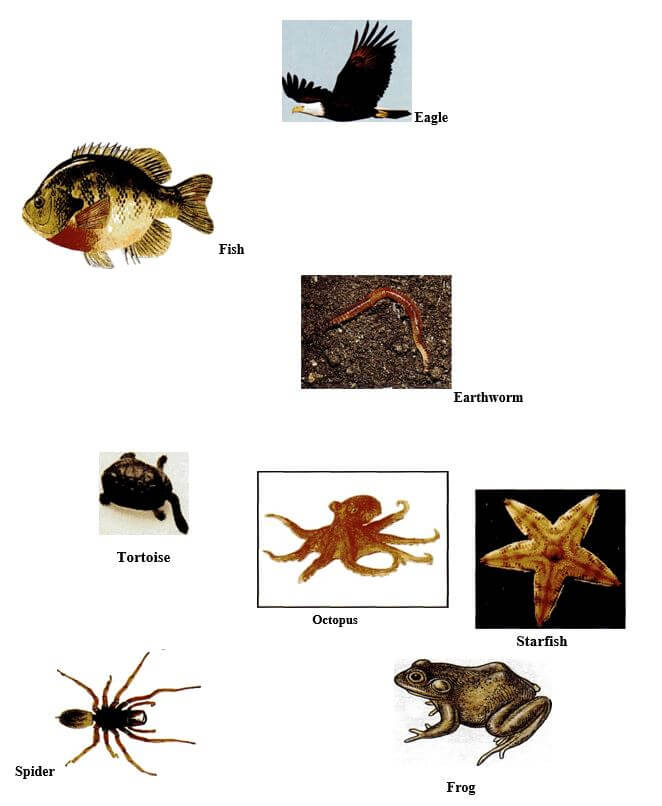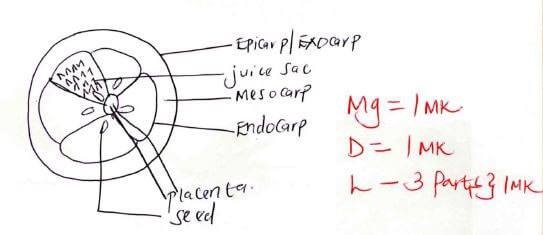INSTRUCTIONS TO CANDIDATES
- Write your Name,Class and Adm No. in the spaces provided above
- Answer ALL the questions in the spaces provided
FOR EXAMINERS USE ONLY
|
QUESTION |
MAXIMUM SCORE |
CANDIDATES SCORE |
|
1 |
||
|
2 |
||
|
3 |
||
|
TOTAL |
40 |

QUESTIONS
- You are provided with specimen X (Soaked maize grain), Specimen K, Benedict’s solution, Iodine solution, Pestle and mortar, scalpel and distilled water.
- Name the type of fruit represented in X above (1mk)
……………………………………………………………………………………………… - Give one reason for the above identity (1mk)
…………………………………………………………………………………………………………………………………………………………………………………………………… - Crush the specimen X using pestle and mortar and dissolve in 4cm3 of distilled water. Divide the mixture into two equal portions and use them to carry out the following food test. Record your observations in the table below: (6marks)
Food Test Procedure Observation Conclusion Starch Reducing sugars - Account for the observations made in the above table in relation to starch and reducing sugar. (3mks)
- Identify the type of placentation in the specimen K above (1mk)
- Name the type of fruit represented in X above (1mk)
- Describe how the above placentation was formed (2mks)
- Using a scalpel, make a transverse section of specimen K. Draw the section of and label its parts (3mks)
- You are provided with specimen X (Soaked maize grain), Specimen K, Benedict’s solution, Iodine solution, Pestle and mortar, scalpel and distilled water.
- Using the pictures of animals provided below, complete the construction of the dichotomous key by filling the blank spaces. (13 marks)

1a Animals with backbone……………………………………………………….Go to 2
b Animals without backbone …………………………………………………
2 a Animals with wings………………………………………………………….
b Animals without wings………………………………………………………
3a Animals which live in water all the time…………………………………....
b Animals which live in water for some time………………………………….
4a Animals with scales………………………………………………………….
b Animals without scales………………………………………………………
5a Animals with legs……………………………………………………………
b Animals without legs………………………………………………………… Go to 7
6a Animals with six legs……………………………………………………….. Butterfly
b Animals with eight legs……………………………………………………..
7a Animals with a shell………………………………………………………..Snail
b Animals without a shell……………………………………………………..
8a Animals with jelly-like body…………………………………………………
b Animals without a jelly-like body…………………………………………….
9a Animals with a segmented body……………………………………………….
b Animals without segmented body…………………………………………….. Octopus - You are provided with starch solution, Iodine solution, Visking tubing, stirring road, 2 pieces of thread, measuring cylinder and a beaker. Tie one end of the visking tubing and pour about 2mls of iodine solution into it. Tie the other end making sure no iodine solution leaks and place the visking tubing into starch solution in the beaker. Leave the set up for about 30 minutes and note the observations
- Account for the observations made after 30 minutes (3mks)
- Give the role of the physiological process investigated above in:
- Reproduction (1mk) ………………………………………………………………………………………………………………………………………………………………
- Respiration (1mk) ………………………………………………………………………………………………………………………………………………………………
- Name two parts in the alimentary canal where starch is digested (2mks)
- Identify one hormone and one digestive enzyme that stimulates digestion of starch in the parts identified in (iv) above (2mks)
- What deficiency disease results when an individual lacks starch in their diet? (1mk)

Marking scheme
- You are provided with specimen X (Soaked maize grain), Specimen K, Benedict’s solution, Iodine solution, Pestle and mortar, scalpel and distilled water.
- Name the type of fruit represented in X above (1mk)
Caryopsis - Give one reason for the above identity (1mk)
Pericap and seed coat are fused together to form a thin covering over the entire seed - Crush the specimen X using pestle and mortar and dissolve in 4cm3 of distilled water. Divide the mixture into two equal portions and use them to carry out the following food test. Record your observations in the table below: (6marks)
Food Test Procedure Observation Conclusion Starch Put 2cm3 of the paste into the test tube .
Add 3 drops of iodine solution.Blue-black colouration. Starch present.
Rej. presence of starchReducing sugars Put 2cm3 of the paste in the test tube.
Add an equal amount of Benedict's solution.
Place it in a hot water bath.Colour changes from blue to green to yellow to orange. Reducing sugars present
Rej. presence of Reducing sugars - Account for the observations made in the above table in relation to starch and reducing sugar. (3mks)
Plants store food/ carbohydrates in form of starch; reducing sugars
Some starch was hydrolyzed; by enzyme .......... to reducing sugars - Identify the type of placentation in the specimen K above (1mk)
Axile placentation
Rej; Axial placentation
- Name the type of fruit represented in X above (1mk)
- Describe how the above placentation was formed (2mks)
Edges of carpels fuse together to form a central placenta in which axile formed by carpels,. Ovules arranged on the placenta and ovary divided into a anumber of loculi by the walls of the carpel. - Using a scalpel, make a transverse section of specimen K. Draw the section of and label its parts (3mks)

- You are provided with specimen X (Soaked maize grain), Specimen K, Benedict’s solution, Iodine solution, Pestle and mortar, scalpel and distilled water.
- Using the pictures of animals provided below, complete the construction of the dichotomous key by filling the blank spaces. (13 marks)

1a Animals with backbone……………………………………………………….Go to 2
b Animals without backbone …………………………………………………go to 5
2 a Animals with wings………………………………………………………….Eagle
b Animals without wings………………………………………………………go to 3
3a Animals which live in water all the time…………………………………....fish
b Animals which live in water for some time………………………………….go to 4
4a Animals with scales………………………………………………………….tortoise
b Animals without scales………………………………………………………frog
5a Animals with legs……………………………………………………………go to 6
b Animals without legs………………………………………………………… Go to 7
6a Animals with six legs……………………………………………………….. Butterfly
b Animals with eight legs……………………………………………………..spider
7a Animals with a shell………………………………………………………..Snail
b Animals without a shell……………………………………………………..go to 8
8a Animals with jelly-like body…………………………………………………go to 9
b Animals without a jelly-like body…………………………………………….starfish
9a Animals with a segmented body……………………………………………….earthworm
b Animals without segmented body…………………………………………….. Octopus - You are provided with starch solution, Iodine solution, Visking tubing, stirring road, 2 pieces of thread, measuring cylinder and a beaker. Tie one end of the visking tubing and pour about 2mls of iodine solution into it. Tie the other end making sure no iodine solution leaks and place the visking tubing into starch solution in the beaker. Leave the set up for about 30 minutes and note the observations
- Identify the physiological process being investigated (1mk)
Diffusion - Account for the observations made after 30 minutes (3mks)
Starch in the beaker turned blue-black
iodine molecules have smaller moleecular size compared to startch molecules
they then diffuse through the tiny pores in the visking tubing turning into blue-black - Give the role of the physiological process investigated above in:
- Reproduction (1mk) flowers produce scent that diffuses to attract pollinators.
pheromones diffuse from the females to attract the males - Gaseous exchange(1mk)
oxygen inhaled diffuses through the alveolis capillaries into the blodd
CO2 breathed out diffused from blood capillaries - alveoli
- Reproduction (1mk) flowers produce scent that diffuses to attract pollinators.
- Name two parts in the alimentary canal where starch is digested (2mks)
- mouth
- duodenum
- illeum
- Identify one hormone and one digestive enzyme that stimulates digestion of starch in the parts identified in (iv) above (2mks)
- secretin
- pancreatic analase
- What deficiency disease results when an individual lacks starch in their diet? (1mk)
- marasmus
- Identify the physiological process being investigated (1mk)

CONFIDENTIAL
- Specimen K. An mature orange (with seeds)-1 per student
- Iodine solution.
- Mortar and pestle
- Stirring rod
- Pieces of thread (2 pieces per student)
- Benedict’s solution
- Soaked maize cereal (soaked for 3 days)(specimen X
- Visking tubing (8cm)
- Dropper
- At least three test tubes
- Distilled water
- Source of heat (Warm water bath)
- Scalpel
Download Biology Paper 3 Pre Mock Questions, Answers and Confidential - Mokasa I Joint Examination July 2021.
Tap Here to Download for 50/-
Get on WhatsApp for 50/-
Why download?
- ✔ To read offline at any time.
- ✔ To Print at your convenience
- ✔ Share Easily with Friends / Students

